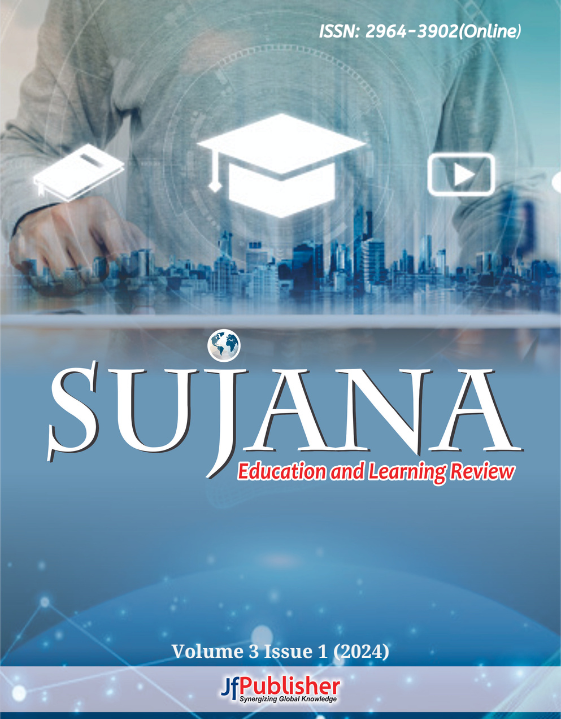THE EFFECT OF KOH AND CACO3 SOLUTION CONCENTRATION ON THE QUALITY OF ALKALI TREATED COTTONII CHIPS (ATCC) PRODUCED
Universitas Negeri Makassar
Universitas Negeri Makassar
Universitas Negeri Makassar
DOI:
https://doi.org/10.56943/sujana.v3i1.571The alkali treatment process typically employs KOH (potassium hydroxide) and CaCO3 (calcium carbonate) to modify Cottonii's cellular structure, facilitating carrageenan extraction and enhancing the final product's quality. The concentration of these solutions significantly impacts the quality of Alkali Treated Cottonii Chips (ATCC). This research aims to determine the effect of KOH and CaCO3 concentrations in the soaking and bleaching process on the quality of Alkali Treated Cottoni Chips (ATCC) produced. The ATCC processing was conducted by adding the concentration of KOH and CaCO3 solution in each treatment. Observations made in this research are water content and pH while for the analysis of the test is gel strength and carrageenan. This research is an experimental study using a Completely Randomized Design (CRD) with a factorial pattern consisting of 2 factors. The results of this research indicate the effect of the concentration of KOH and CaCO3 solutions on the processing of Alkali Treated Cottoni Chips (ATCC) is significantly influential on the quality of ATCC where KOH and CaCO3 contribute to the determination of the analysis of the physical and chemical properties of ATCC both from the ability of KOH to inhibit the rate of water content, pH, and the ability of KOH and CaCO3 in gel formation. The maximum standard of water content of ATCC is 12% in this research, the lowest water content is A3B3 with a value of 9.74%, the highest is A1B1 with a value of 11.72%, for the pH of ATCC, the value ranges between pH 8-11, the pH of A1B1 treatment with the lowest value of 8.66 and the highest is A3B3 with a value of 9.22, while for the highest gel strength is A3B3 treatment with a value of 150.70g and for carrageenan, the highest value is obtained in A2B2 treatment with a value of 65.98%.
Keywords: ATCC Processing CaCO3 Eucheuma Cottonii Seaweed KOH Quality
Anwar, F., Djunaedi, A., & Santosa, G. W. (2013). Pengaruh Konsentrasi KOH yang Berbeda Terhadap Kualitas Alginat Rumput Laut Coklat Sargassum duplicatum J. G. Agardh. Journal of Marine Research, 2(1), 7–14. https://doi.org/https://doi.org/10.14710/jmr.v2i1.2049
Baghel, R. S., Choudhary, B., Pandey, S., Pathak, P. K., Patel, M. K., & Mishra, A. (2023). Rehashing Our Insight of Seaweeds as a Potential Source of Foods, Nutraceuticals, and Pharmaceuticals. Foods, 12(19), 3642. https://doi.org/10.3390/foods12193642
Buschmann, A. H., Camus, C., Infante, J., Neori, A., Israel, Á., Hernández-González, M. C., Pereda, S. V., Gomez-Pinchetti, J. L., Golberg, A., Tadmor-Shalev, N., & Critchley, A. T. (2017). Seaweed production: overview of the global state of exploitation, farming and emerging research activity. European Journal of Phycology, 52(4), 391–406. https://doi.org/10.1080/09670262.2017.1365175
Desiana, E., & Hendrawati, T. Y. (2015). Pembuatan Karagenan dari Eucheuma Cottonii dengan Ekstraksi KOH menggunakan Variabel Waktu Ekstraksi. Prosiding Seminar Nasional Sains Dan Teknologi.
Diharmi, A., Rusnawati, & Irasari, N. (2020). Characteristic of carrageenan Eucheuma cottonii collected from the coast of Tanjung Medang Village and Jaga Island, Riau. IOP Conference Series: Earth and Environmental Science, 404(1), 012049. https://doi.org/10.1088/1755-1315/404/1/012049
Doty, M. S. (1985). Eucheuma alvarezii sp.nov (Gigartinales, Rhodophyta) from Malaysia. California Sea Grant College Program.
Frank, J. (2015). Carrageenan Deep Dive – Kappa, Iota and Lambda. Ultrus Prospector Knowledge Center.
Lomartire, S., & Gonçalves, A. M. M. (2023). Algal Phycocolloids: Bioactivities and Pharmaceutical Applications. Marine Drugs, 21(7), 384. https://doi.org/10.3390/md21070384
Nurani, W., Anwar, Y., Batubara, I., Arung, E. T., & Fatriasari, W. (2024). Eucheuma cottonii as a renewable source of kappa-carrageenan and other cosmetic ingredients. International Journal of Biological Macromolecules, 129458. https://doi.org/10.1016/j.ijbiomac.2024.129458
Prajapati, V. D., Maheriya, P. M., Jani, G. K., & Solanki, H. K. (2014). Carrageenan: A natural seaweed polysaccharide and its applications. Carbohydrate Polymers, 105(1), 97–112. https://doi.org/10.1016/j.carbpol.2014.01.067
Pumpente, O. I., Nugroho, L. P. E., & Syarief, R. (2019). Physical Quality and Yield of Alkali Treated Cottonii at Various Levels of NaOH Concentration, Temperature and Extraction Time. Jurnal Keteknikan Pertanian, 07(1), 57–64. https://doi.org/10.19028/jtep.07.1.57-64
Sumule, O., Angkasa, W. I., Retno, H. W., & Andiewati, S. (2021). The Development of Indonesian Seaweed based on Innovation Cluster Model. IOP Conf. Series: Earth and Environmental Science.
Surni, W. (2014). Pertumbuhan Rumput Laut (Eucheuma Cottonii) pada Kedalaman Air Laut yang berbeda di Dusun Kotania Desa Eti Kecamatan Seram Barat Kabupaten Seram Bagian Barat. BIOPENDIX: Jurnal Biologi, Pendidikan Dan Terapan, 1(1), 95–104. https://doi.org/10.30598/biopendixvol1issue1page95-104
Wenno, M. R., Thenu, J. L., & Cristina Lopulalan, C. G. (2012). Karakteristik Kappa Karaginan dari Kappaphycus alvarezii Pada Berbagai Umur Panen. Jurnal Pascapanen Dan Bioteknologi Kelautan Dan Perikanan, 7(1), 61. https://doi.org/10.15578/jpbkp.v7i1.69
Zainuddin, Z. (2023). Potensi Pengolahan Dan Pengelolaan Budidaya Rumput Laut (Kappaphycus alvarezii) Di Wilayah Provinsi Kalimantan Utara. Jurnal Teknologi Pangan Dan Industri Perkebunan (LIPIDA), 3(1), 1–17. https://doi.org/10.58466/lipida.v3i1.1412
Zambrano, M. V., Dutta, B., Mercer, D. G., MacLean, H. L., & Touchie, M. F. (2019). Assessment of Moisture Content Measurement Methods of Dried Food Products in Small-Scale Operations in Developing Countries: A Review. Trends in Food Science & Technology, 88, 484–496.

